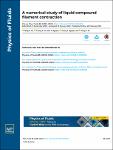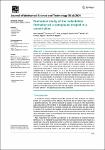Browsing by Author Nguyen, Cuong T.
Showing results [1 - 3] / 3
Droplets resulting from liquid filament contraction have been widely used in industrial processes. However, detailed investigations of liquid compound filament contraction processes are lacking in the literature. Therefore, this study provides a numerical investigation of the contraction of a two-layered compound filament. The simulations are based on an axisymmetric front-tracking method. It is found that because of the interfacial tension force, the initially long cylindrical filament contracts to a compound droplet without any breakup or breaks up into smaller droplets during contraction. Unlike simple filaments, the presence of the inner filament inside the compound filament resul... |
Compound droplets with different sizes are increasingly used in industrial production and academic research. This study aims to improve understanding of the dynamical behaviors of the compound droplet moving in microchannels. The compound droplet consisting of one inner core is initially concentric and placed at the entrance of a circular channel with a cone at the downstream region. Following this primary channel is a secondary channel that is circular and straight. Manipulation of the droplet is assisted by a flow introduced via the gap between two channels. The numerical results show that when passing through these confined channels, the droplet experiences a finite deformation or ... |
A compound droplet deforming in a constricted tube widely appears in drug delivery and microfluidic devices. In such a constriction, an indentation can present at the trailing surface of the droplet. However, this aspect has not been fully investigated and understood so far. This study focuses on the effects of some dimensionless parameters on the negative curvature, i.e., indentation, at the trailing surface of a compound droplet moving through a constricted tube. The presence of the constriction at the middle of the tube length enhances the droplet indentation. Numerical results were obtained for the capillary number Ca (varied in range of 0.1–1.0), the inner-to-outer droplet radius... |



